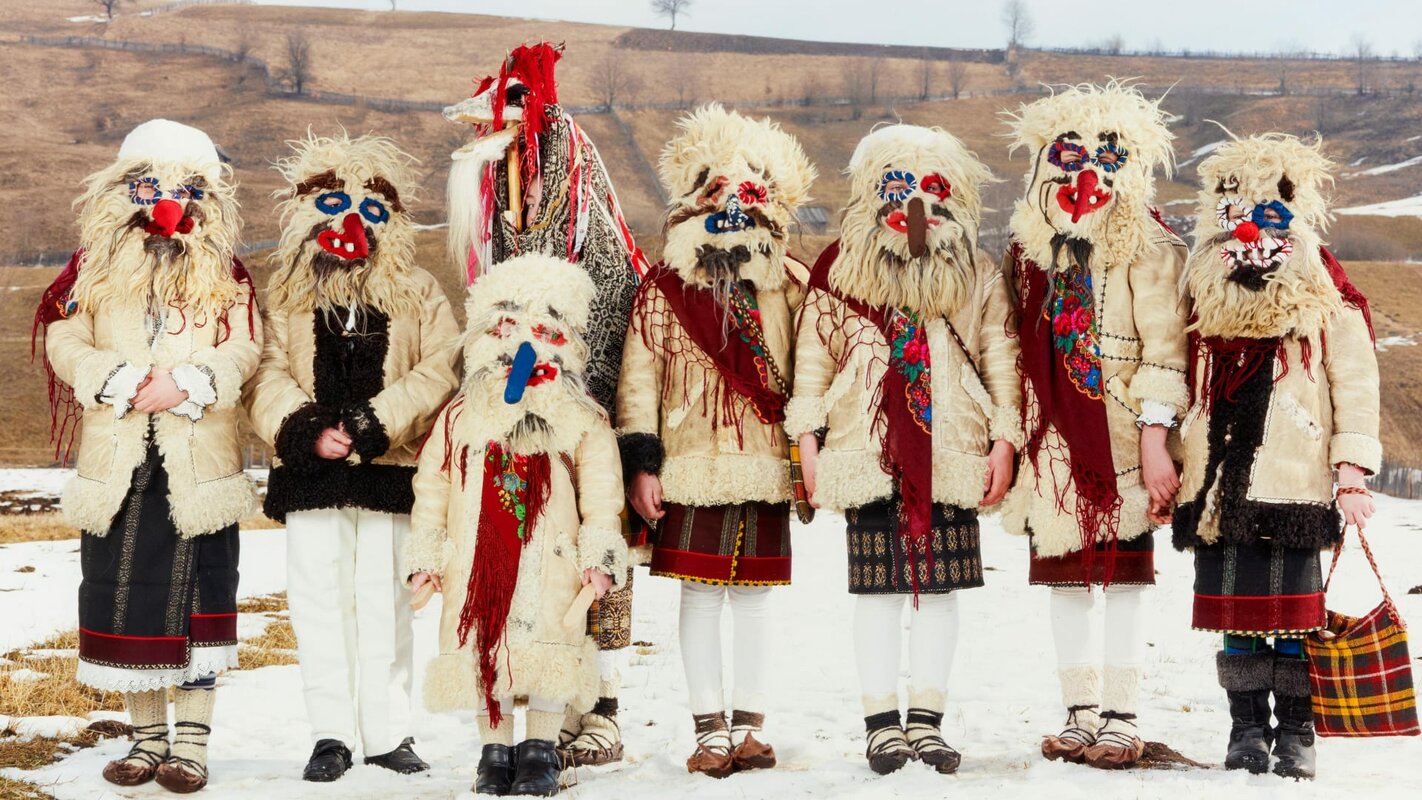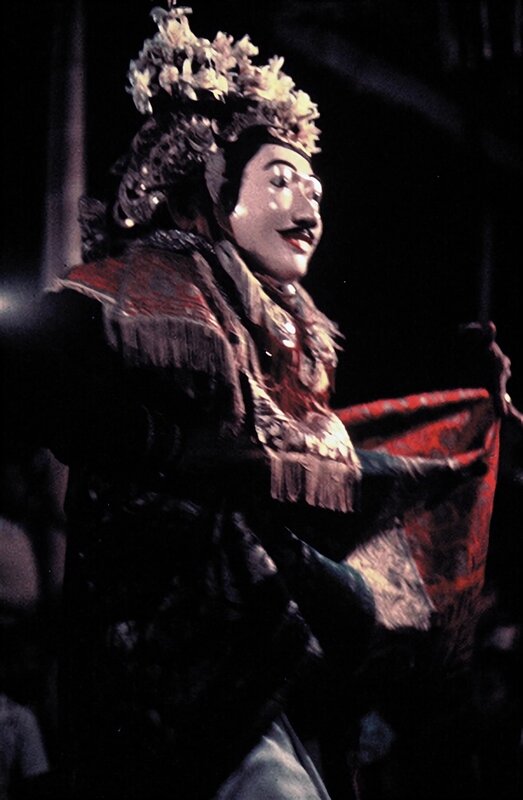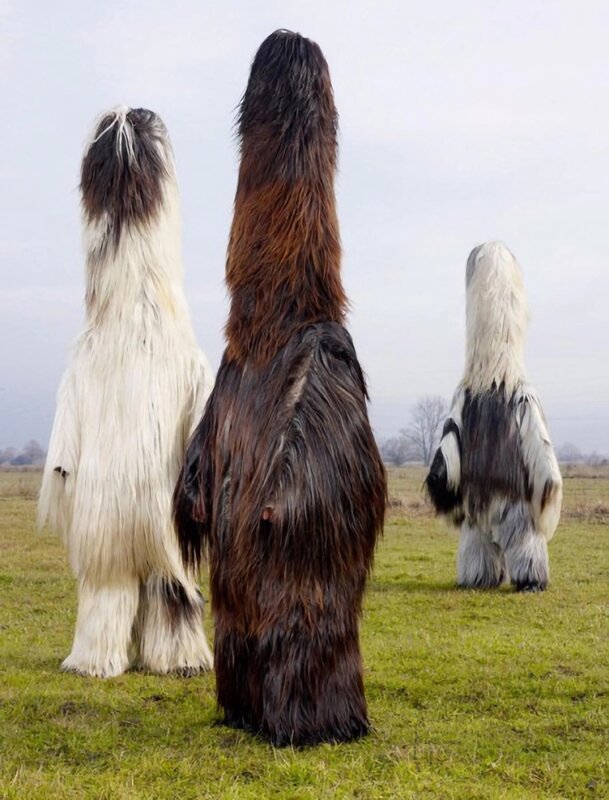
John Emigh: MASK AND BODY
John Emigh is Professor Emeritus of Theatre Arts and Performance Studies at Brown University, Providence, RI, USA. He also works as theatre director and performer. In this essay, he explains how every mask should be understood in its performative quality – and not as a mere artifact.
Masks are not meant to be complete. They are not sculptures, or are so only accidentally. They await not only animation – as puppets arguably do – but the complementary presence of a human body. Decorative masks exist, to be sure, but even then the heritage of the worn mask and the implicit presence of a body is invoked in the spectator’s imagination. In African usage, and in the lingo of the commedia dell‘arte performer, the ‘mask’ refers not only to the surrogate face that is ‘put on’, but also to the costume, bodily postures, and dance moves that accompany the wearing of that ‘face’. The masked performer creates a cognitive puzzle for the viewer. What we know to be inanimate matter, the result of craftsmanship and whimsy, of observation and imagination – a more or less inflexible object made to look, more or less, like the face of a human, an animal, or a deity – is temporarily fused in identity with the human fragility of a living body, subject to age and abuse, but also able to move and be moved.

Masks partake of the uncanny – the unheimliche – familiar and foreign at the same time. Small wonder, then, that masks are (still) frequently used in Shamanic ceremonies (often involving altered states of consciousness) in order to facilitate the ability to move between the domains of everyday experience and virtual realms held in shared imagination, giving form to myth and power to the healer. The frequent use of masks in ceremonies of the dead (and sometimes, as in ancient Egypt, Rome, Siberia, and Meso-America on the actual bodies of the deceased) may seem to counter this statement; but in these instances, the mask gestures back to the once living body, fusing it with something more durative, resisting decay, and suggesting a permanence of spirit.
While masks frequently hark back to referents in the observable world, they are rarely exact copies of anything found in that world. There is a movement away from the quotidian and towards the essential through a simultaneous process of simplification and amplification. Cognitive neuroscientists V. S. Ramachandran and William Hirstein identify a tendency in artistic production to ‘enhance, transcend, or even to distort reality’ in accordance with a ‘peak shift principle’: ‘the ability … to abstract the “essential features” of an image and discard redundant information.’ They further note that this is essentially ‘what the human visual areas themselves have evolved to do’. When dealing with representations of the human face, this ‘peak shift effect’ constitutes a stripping away of inessential information and a directing of attention to features we naturally look to for information about intent and disposition: the eyes, the nose, the lips, the ears, the overall shape of the face.

Studies have shown that a skilful caricature or sketch can be identified significantly more quickly than a photograph, the density of information in the photograph being a disadvantage. In my experience, some of the masks that are most effective in performance are ones that might be considered less artistically compelling. Their incompleteness as objects allows more opportunity for the performer to bring the mask to life.
When a Balinese topeng performer picks up a mask being considered for purchase, he (or, rarely in this tradition, she) holds the mask in the right hand, fingers lightly over the carved hairline, the wrist forming an imaginary ‘neck’. As the perfomer gazes upon the mask, turning it this way and that, making it move to a silent music, he is assessing its potential life. He searches for a meeting-place between himself and whatever life is inherent in the mask’s otherness. If he is successful, then a bonding takes place that will allow him to let that potential life flow through his own body. If he finds that place of congruence between his physical and spiritual resources and the potential life of the mask, then a living amalgam is created: a character, a persona. This amalgam is at best unstable – based as it must be upon paradox, ambiguity, and illusion – but ‘it’ moves, ‘it’ speaks, ‘it’ breathes, ‘it’ is perceived – by the performer and by the audience – as having an organic integrity. The process begins with a respect for the mask’s potential life as a separate entity and proceeds by narrowing the gap between self and other through a process of imaginative play.
The meeting place – the common ground found in this process – must be specific and precise. Ultimately, it must be located within the performer’s own body, providing a locus of energy that will support and resonate with the mask’s appearance in order to create a character – an ethos in Aristotle’s suggestive terminology – that gives its fragile testament to yet one more way of being alive. In doing this, the mask does not hide or obscure; it is a revelatory device. As Peter Brook has noted in reference to the Balinese masks made for him by Ida Bagus Anom for (non-traditional) use, ‘the traditional mask . . . is an image of the essential nature. In other words, a traditional mask is an image of a man without a mask . . . an outer casing that is a complete and sensitive reflection of the inner life.’

Sometimes, masks further emphasize the contribution of the body. The half-masks and nose masks of Italian commedia and the wire-mesh masks of the Austrian Alps, Mexico and the Caribbean are examples. Sometimes the masks are large and reference beasts of prey, demonic presences, or protective gods. Such masks – threatening, protective, or both – are found around the world and seem to relate to the body’s own neural mapping of the un-socialized body.
Masks can be used to conceal as well as reveal identity. They may take on an iconic identity and be used to diminish difference, to fold individuals into a group identity. Paradoxically, these new masked identities can be used to celebrate the untamed, anti-social and mischievous urges within human bodies. Thus, the historically Catholic villages and free towns of Baden and Swabia develop and maintain specific mask traditions and police the right of fasnet guild members to wear the faces of the devils, animals, witches, narren, or burghers associated with that place only. With such a multiplication of more or less identical false faces, it is no longer the face of a person (or god or animal), real or imagined, that is being duplicated and worn, but rather the face of the village itself in carnival mode. The cliques of Basel design new masks each year in a more modern and satirically focused variant of this tradition.
The advancing crowd of anarchist revolutionaries wearing starkly simple, glaring white, and grinning plastic Guy Fawkes masks at the end of the recent film V for Vendetta (2005) provides a striking example of this capacity of the mask to both expand and contract individual identity, and to generate unsettling reactions. The leering iconic face loosely refers back to an historical attempt to blow up the English Parliament – an attempt that has long since been submerged into a more general impulse towards carnivalesque humour in British folk ways. The hundreds of advancing masked figures, though, restore to the familiar image power and menace as individual identities are erased and supplanted by the implacable, identical, mass-produced masks – worn, paradoxically (the narrative assures us) in the service of greater human freedom.
Originally published in Prepare for Pictopia, 2009
- 291 views
- 0x empathy